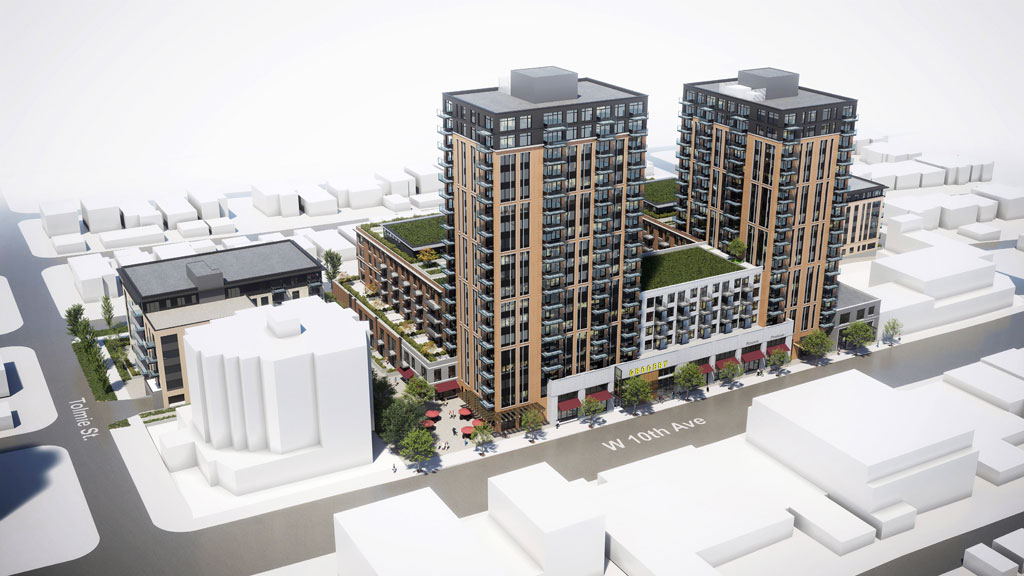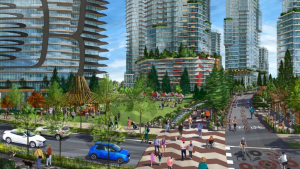The City of Vancouver recently received an application from developer BGO to rezone the former West Point Grey Safeway site from C-2 (commercial) to CD-1 (comprehensive development).
BGO (formerly BentallGreenOak) has proposed a mixed-use development on the north side of the 4500 block of West 10th Avenue, a busy street that leads to the University of British Columbia (UBC).
Plans call for two six-storey buildings, a central building, and 17-storey and 19-storey towers.
There will be 455 market rental units and 114 moderate income rental units, for a total of 569 units.
In addition, 444 vehicle parking spaces and 1,107 bicycle parking spaces will be located in a two-level underground parking garage.
On the ground floor there will be commercial space, including room for a grocery store.
The development will occupy the three-acre former site of Safeway, which supplied the neighbourhood with groceries from the mid-1960s until it closed in 2018. The store was later demolished and the site is now occupied by a municipal garden/dog park.
Safeway was one of the anchor businesses of Point Grey Village (PGV), a three-block-long commercial strip.
After Safeway closed, other smaller businesses, which had hitherto been well patronized, began to shut their doors one by one.
“Business on West 10th has really slowed in the last 15 years or so, with a big decline in foot traffic on the street,” says Marion Fudge, president of the PGV Business Improvement Association (BIA) and local business owner. “That’s the result of several different things – the construction of Wesbrook Village near the UBC campus, which has drawn many of the students and faculty who used to shop in the village; the closing of Safeway; increased online shopping; and changing neighbourhood demographics.
“There’s a ‘missing middle’ of the young families who used to live here, as West Point Grey has become unaffordable for most people. It’s been one thing after another for the village.”
Fudge is pleased the development will contain some affordable housing and she is optimistic it will increase foot traffic.
“But we’re worried it could also encourage other landlords on 10th Avenue to raise their rents,” she says. “Will greater foot traffic cover the higher cost of doing business?”
Fudge says the BIA has not taken an official position on the development.
“Some members are for the development as it is now, and some are against it,” she says.
Jean Baird, chairwoman of Friends of Point Grey Village (FPGV), is not a fan of the design.
“To bring the village back to life will require imagination and creative thinking,” says Baird. “The design looks like it was done on a financial spreadsheet. It belongs downtown, not in West Point Grey.”
It’s not a “friendly development,” she adds.
“It’s too big, it’s overbuilt and it has no street appeal,” says Baird. “The development’s density is excessive and not well placed on the site. You don’t plunk a fortress down in the middle of a village. We need a development that provides a sense of community.”
Christina DeMarco, a FPGV member, says there are three things the developer’s current design does well.
“A good supply of market housing units, a good supply of below-market units, and a grocery store to replace Safeway,” says DeMarco.
The development will represent one-third of the total tax assessment of PGV, which makes it economically important to the neighbourhood.
“But the design isn’t good enough for a large site,” she says. “It should support the local economy and public life, but it’s very weak on both counts.”
In early February, the city held a three-hour open house to get feedback from the development’s neighbours on the BGO rezoning application.
The open house was followed two weeks later by the developer’s presentation to the city’s urban design panel (UDP).
Jason Olinek, Vancouver’s director of development planning, says the UDP had some recommendations on the design for the developer.
“The general themes of the panel’s recommendations were improvements to tower placement and distribution of density; commercial retail interface with the public realm as well as public realm design; the architectural expression of the two towers; and residential unit mix,” says Olinek. “Consensus recommendations are not finalized until two weeks after the meeting and will be posted as minutes online.”
The developer is not required to follow the panel’s suggestions.
“The panel makes recommendations to council, the director of planning and staff, and the recommendations are evaluated as part of the city’s review process,” says Olinek.
When contacted by the Journal of Commerce about the UDP’s recommendations, David Roche, BGO’s vice president, development, declined comment.




Recent Comments